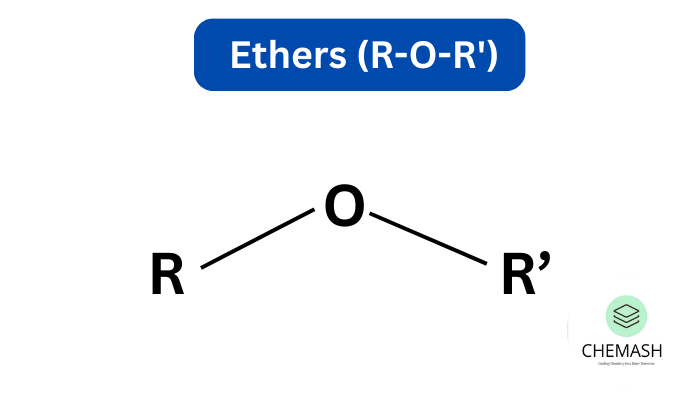Ethers – Detailed Explanation
Ethers are a class of organic compounds characterized by an oxygen atom connected to two alkyl or aryl groups. The general formula of ethers is R–O–R′, where R and R′ can be the same or different. Ethers are important industrially and biologically, and are less reactive compared to alcohols.

1. Classification of Ethers
A. Based on Hydrocarbon Groups
- Simple (Symmetrical) Ethers: Both groups same. Example: Diethyl ether (C₄H₁₀O)
- Mixed (Unsymmetrical) Ethers: Groups different. Example: Methyl ethyl ether
B. Based on Type of Group
- Aliphatic Ethers: Both groups alkyl. Example: Diisopropyl ether
- Aromatic Ethers: At least one aryl. Example: Anisole (C₆H₅–OCH₃)
2. Nomenclature of Ethers
A. Common System
Example names:
- CH₃–O–CH₃ → Dimethyl ether
- CH₃–O–C₂H₅ → Methyl ethyl ether
B. IUPAC System
- CH₃–O–CH₂CH₃ → Methoxyethane
- C₆H₅–O–CH₃ → Methoxybenzene (Anisole)
3. Structure of Ethers
Ethers have a bent geometry at oxygen with bond angle ~110°. C–O–C bonds are σ-bonds formed by sp³ hybrid orbitals.
4. Preparation of Ethers
- Williamson Ether Synthesis: R–O⁻ + R′–X → R–O–R′ + X⁻
- Dehydration of Alcohols: 2 R–OH → R–O–R + H₂O (with H₂SO₄, 413 K)
5. Physical Properties
- Colorless, volatile liquids
- Boiling points lower than alcohols
- Slightly soluble in water
- Good organic solvents
6. Chemical Properties
- Reaction with Acids: R–O–R′ + HI → R–I + R′–OH
- Peroxide Formation: R–O–R + O₂ → R–O–O–R
7. Uses of Ethers
- Industrial solvents
- Former anesthetic (diethyl ether)
- Perfumes & pharmaceuticals (anisole)
- Used with Grignard reagents
